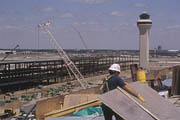A Nice Place to Wait for Your Luggage


These are just a few of the problems that have challenged construction of the Midfield Terminal at Detroit’s Metro Airport. As far as the roof is concerned, however, everything has gone according to plan.
And what a roof it is! Installed by Crown Corr Inc., Gary, Ind.,(see the May 2000 issue of Roofing Contractor for a company profile), the Midfield Terminal has a 6,500-square structural standing seem stainless steel roof. The Bemo 400-millimeter system has 15 3/4-inch wide panels fabricated from 300 series Architex stainless steel manufactured by J&L Steel.
Underneath are 3 inches of polyisocyanurate insulation and a 1/2-inch nail base. GAF Stormguard underlayment was used in the low-slope areas while Roofshield breathable membrane was put on parts of the roof that were 2:12 and above. (For more information on breathable membranes, see the April 2001 issue of Roofing Contractor.) The products used were speced by the architect, the Smith Group, Detroit. Though, “We gave some product recommendations based on performance,” says John Pickford, Crown Corr’s executive vice president.
As if this weren’t enough, Crown Corr is also responsible for the gutters, about eight miles of snow guards, the curtain wall and the metal wall panels. According to Pickford, this diversity helped the company get the job. In addition to having experience installing curved metal and with several airports on its resume, “Crown Corr offered a complete enclosure package,” says Pickford. “We gave the owner and the general an easier point of contact.”
Logistics, Logistics, Logistics
Work on the Midfield Terminal’s roof began on February 14, 2000, and was scheduled to be complete by the end of March 2001. As can be imagined, the challenges of this job were many. The inherent difficulty, of course, was the sheer size and scope of the project.“One of the biggest challenges involved logistics,” explains Pickford. “We had to figure out the best way to get the material on the roof. This required a lot of planning and the use of big cranes.” In addition, all of the panels were rolled and curved on site using the Bemo machine. The sheets were rolled on the ground and curved on the roof – the longest panels were 275 feet long.
Mike Price, the project superintendent and a 14-year Crown Corr veteran, was largely responsible for navigating the logistical nightmare. “It was a challenge to get the metal on the roof and keep it there while dealing with the high winds that come with airports,” he admits. “We would have to stop handling the metal when the winds got to be around 20-25 miles per hour.”
To bring the sheets to the east and west terminals, the crews built a ramp system. The Bemo roller has a tilt machine to help get the panels up the ramp. For the clear story (the terminal), workers needed a 120-foot spreader beam to lift up the bundles of sheets. They also had to build a 350-foot ramp to roll them onto the roof. To load the terminal, they also had the help of 275-ton D-mag cranes. “The length of the panels made them very hard to lift with the wind,” Price continues. “And once on the roof, we had to use bands, screwed down every 10 feet, to keep the panels in place.”
Safety Precautions
Obviously with a job of this size and scope, safety was a major concern. “There were a lot of edges, steep slopes and winter roofing conditions,” says Pickford. To meet the challenge, “We used a lot of PPEs, purchased new for each employee. We use a 5-point harness and lanyard. We also employed perimeter barricades to make sure men and materials stayed on the roof. We wanted our men to be confident, but not overconfident.” Crown Corr is very diligent for safety: All supervisors go through OSHA 10-hour classes and are trained in scaffolding, fall protection, PPE, CPR, first aid, etc.Again, the details were left to Price. “I designed all of the safety systems, in house, to keep the men on the roof,” he explains. “While we were doing the underlaying, we had to build a perimeter wall. If everyone were tied off, we would have been tripping over one another. When it was time to lay the metal, then the wall came down and everyone was tied off 100 percent.”
And obviously, working on a wide-open metal roof presents electrical hazards as well. Last summer, there was a lightning strike on the site, and several people were hurt. But everyone from Crown Corr was off the roof. “We watch the weather closely,” says Price. “We work with the FAA and they let us know when storms are 20 miles out.”
Winter work was also a challenge to production. “Winter means less hours to work and more time spent on safety preparations,” says Pickford. “That slows down productivity.” And according to Price, “We had to spend time doing snow removal and burning the frost off the roof. We couldn’t work when the temperatures were down in the single digits because of the wind chill.”
Now if the Flights Could Just be on Time …
Overall, Crown Corr was responsible for “everything from 10 ft. 6 up” says Price. “Crews were varied,” he continues, “but at the busiest I had 85 people working for me, doing the siding, glass and roofs. Once we got a system down, everything went smoothly. We had great crews and everyone worked hard. We’re ready for the next project!” Next on the agenda for Crown Corr is work on the Detroit Lions’ new stadium, Ford Field.If all goes according to plan (sometimes, a rather big “if”), the Midfield Terminal will be open for business in December 2001. “There have been a lot of contractual changes on the entire project, and hundreds of bulletins and change directives,” says Pickford. “We’ve been affected by a lot of changes, but the roof has been pretty clean in the overall scope.” Now if only Crown Corr were in charge of the planes …
Looking for a reprint of this article?
From high-res PDFs to custom plaques, order your copy today!





